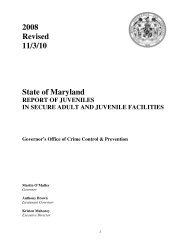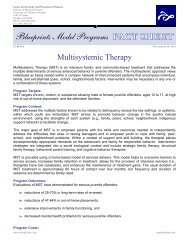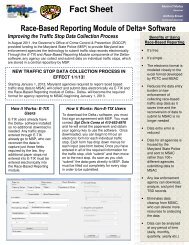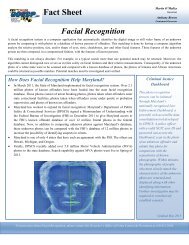Targeted Outreach - Governor's Office of Crime Control & Prevention ...
Targeted Outreach - Governor's Office of Crime Control & Prevention ...
Targeted Outreach - Governor's Office of Crime Control & Prevention ...
Create successful ePaper yourself
Turn your PDF publications into a flip-book with our unique Google optimized e-Paper software.
Introduction 3<br />
A New Approach for Clubs: <strong>Targeted</strong><br />
<strong>Outreach</strong> and Services<br />
In the late 1980s, BGCA embarked on a partnership<br />
with OJJDP involving an extensive pilot project<br />
aimed at reducing youth delinquency. BGCA’s two<br />
comprehensive approaches to gang prevention and<br />
intervention—GPTTO and GITTO—emerged as outgrowths<br />
<strong>of</strong> these strategies, designed to target two<br />
groups <strong>of</strong> particularly hard-to-reach youth, those on<br />
the fringes or at risk for gang involvement, and those<br />
already involved in gang behaviors and a gang<br />
lifestyle. Thirty-three Clubs across the country<br />
piloted and helped to develop GPTTO and GITTO<br />
in the early 1990s.<br />
The prevention approach (GPTTO) provides positive<br />
alternatives for youth with risk factors associated with<br />
gang involvement. The intervention approach<br />
(GITTO) targets youth already involved in gangs or<br />
heavily involved in gang behaviors. The four components<br />
and the overarching objectives <strong>of</strong> these components<br />
(e.g., their intended outcomes), as stated by<br />
BGCA, are:<br />
• Community mobilization <strong>of</strong> resources to combat<br />
the community gang problem;<br />
• Recruitment <strong>of</strong> 50 youth at risk <strong>of</strong> gang involvement<br />
(prevention) or 35 youth already involved<br />
in gangs (intervention) through outreach and<br />
referrals;<br />
• Promoting positive developmental experiences<br />
for these youth by developing interest-based<br />
programs that also address the youth’s specific<br />
needs through programming and mainstreaming<br />
<strong>of</strong> youth into the Clubs; and<br />
• Providing individualized case management<br />
across four areas (law enforcement/juvenile justice,<br />
school, family and Club) to target youth to<br />
decrease gang-related behaviors 5 and contact<br />
with the juvenile justice system, and to increase<br />
the likelihood that they will attend school and<br />
show improved academic success.<br />
Because one approach is preventive and the other an<br />
intervention with youth who are already exhibiting<br />
gang behaviors, these components translate into different<br />
strategies for implementation. For example,<br />
the youth in the intervention project need different<br />
services (e.g., drug treatment, tattoo removal, job<br />
training, educational services) than those in the<br />
prevention group. Therefore, the organizations with<br />
whom Clubs develop their network would also differ.<br />
Furthermore, for prevention youth, the point at<br />
which a youth might be mainstreamed into Club programming<br />
is immediate, whereas it occurs much<br />
later for a hardcore gang member or youth who has<br />
been more entrenched in the gang lifestyle and negative<br />
behaviors. Nevertheless, each <strong>of</strong> the four components<br />
is a building block for the success <strong>of</strong> both<br />
the intervention and the prevention strategies.<br />
Because the approaches undertaken by each Club<br />
are designed within the framework <strong>of</strong> the four components<br />
<strong>of</strong> GPTTO and GITTO (and their intended<br />
outcomes), there are many similarities among Clubs<br />
and how they operate their initiatives. However,<br />
because the Clubs’ communities, gang problems,<br />
resources and infrastructure differ, there is not one<br />
specific way to conduct GPTTO or GITTO; and<br />
therefore, there is not a single model or program<br />
that all Clubs implement. Each Club identifies the<br />
specifics: target populations, based on the risk factors<br />
prevalent for gangs in their area; the community<br />
agencies with which they will collaborate; and the<br />
programming they will <strong>of</strong>fer based on the needs and<br />
interests <strong>of</strong> the groups <strong>of</strong> youth they serve. As such,<br />
there is no specific model or “program” to describe;<br />
rather, throughout the report, we describe the<br />
approaches taken by the Clubs to address the four<br />
components <strong>of</strong> the initiatives.<br />
A major component <strong>of</strong> both GPTTO and GITTO is<br />
the Clubs’ attention to recruitment <strong>of</strong> hard-to-reach<br />
youth. Club staff develop strategies to draw in youth<br />
who have not typically been involved in productive<br />
after-school activities, and those who might not have<br />
joined the Club without some external encouragement.<br />
The Clubs use direct outreach and referrals<br />
from such agencies as school, social service, police<br />
and probation to identify and recruit target youth.<br />
Clubs that implement the prevention model focus on<br />
mainstreaming GPTTO youth into Club activities<br />
without labeling them. Although these youth are<br />
“case managed,” Club staff work to keep the process<br />
“transparent.”<br />
Clubs that have developed an intervention model<br />
may serve youth separately from those youth who are<br />
attending the existing Boys & Girls Clubs (e.g., after<br />
regular Club hours, in a separate location or through<br />
individualized case management services that are not

















